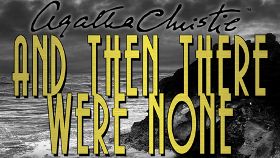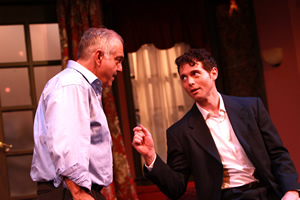THEY’RE DROPPING LIKE FLIES AT ACTORS CO-OP
Since it was first published in1939, Agatha Christie’s And Then There Were None (originally titled Ten Little Niggers and quickly renamed for the 2nd printing) has sold over 100 million copies, making it the best-selling mystery novel of all time. In 1943 Dame Aggie adapted the novel for the London stage and it later transferred to Broadway in 1944 as Ten Little Indians. For nearly 75 years it has been a staple in 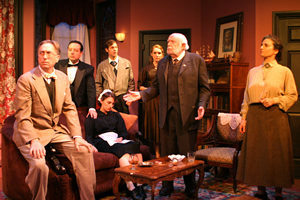 the repertoire of theatre companies around the world. In fact it’s so frequently done that there are at least two productions currently running in Los Angeles. I checked out the Actors Co-op presentation in Hollywood.
the repertoire of theatre companies around the world. In fact it’s so frequently done that there are at least two productions currently running in Los Angeles. I checked out the Actors Co-op presentation in Hollywood.
The plot is a fairly simple one. Ten strangers are invited to a house on the otherwise deserted Soldier Island, off the coast of Devon, England. They have been summoned there under various guises, and none of them has previously met their host, Mr. Owen. There is only one way on and one way off the island; should a storm arise, the jagged coastline will prevent any escape, and the guests will be trapped and virtually locked off from the rest of the world. Cue the thunder and lightning!
Ms. Christie has populated the tale with an eclectic and intriguing group of characters. We first meet Rogers (Pete Pano) and Mrs. Rogers (Teresa Bisson) who have been retained as butler and housekeeper/cook to attend to the needs of the  soon-to-be-arriving guests. Vera Claythrone (Greyson Chadwick), the newly hired social secretary, enters and is informed by the Rogers that their host has been unavoidably detained and will not be arriving until the next day. As the house fills with the other guests, we meet playboy Anthony Marston (Matthew Grondin), adventurer Captain Philip Lombard (Clay Bunker), ex-detective William Blore (Jack Kandel), retired General Mackenzie (Don Robb), uptight spinster Emily Brent (Deborah Marlowe), pompous judge Sir Lawrence Wargrave and persnickety psychiatrist Dr. Armstrong (Wenzel Jones).
soon-to-be-arriving guests. Vera Claythrone (Greyson Chadwick), the newly hired social secretary, enters and is informed by the Rogers that their host has been unavoidably detained and will not be arriving until the next day. As the house fills with the other guests, we meet playboy Anthony Marston (Matthew Grondin), adventurer Captain Philip Lombard (Clay Bunker), ex-detective William Blore (Jack Kandel), retired General Mackenzie (Don Robb), uptight spinster Emily Brent (Deborah Marlowe), pompous judge Sir Lawrence Wargrave and persnickety psychiatrist Dr. Armstrong (Wenzel Jones).
As the group attempts to decipher why they all have been brought together, a recording mysteriously begins to play, explaining that they all have committed a heinous crime for which they will now be forced to pay with their lives. Their 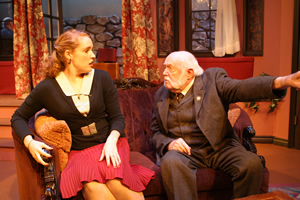 attention is drawn to ten figurines on the mantle and a copy of the nursery rhyme Ten Little Soldier Boys (Ten Little Indians in the American version of the rhyme). The rhyme describes the manner in which each little soldier will meet his demise beginning with “Ten little Soldier boys went out to dine. One choked his little self and then there were nine” and faster than you can say “whodunit” the first victim chokes to death on poison. Panic and paranoia reign as one by one the guests are systematically terminated. With each new murder, one of the figurines vanishes as well.
attention is drawn to ten figurines on the mantle and a copy of the nursery rhyme Ten Little Soldier Boys (Ten Little Indians in the American version of the rhyme). The rhyme describes the manner in which each little soldier will meet his demise beginning with “Ten little Soldier boys went out to dine. One choked his little self and then there were nine” and faster than you can say “whodunit” the first victim chokes to death on poison. Panic and paranoia reign as one by one the guests are systematically terminated. With each new murder, one of the figurines vanishes as well.
Under the direction of Linda Kerns and with the guidance and expertise of dialect coach Jill Massie, the cast has all crafted well rounded, distinct and believable portrayals that successfully bring Ms. Christie’s menagerie to vivid life. 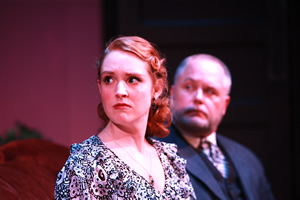 Unfortunately, the prevalence of police procedurals on TV and in the cinema has desensitized the audience, and diluted the effectiveness and shock- value of the script. In addition, Ms. Kearns fails to build any true suspense or terror. The victims simply fall one after another without much fanfare or heightened sense of tension or impending doom. While the actors are involving to watch, and the viewer remains invested, it all doesn’t amount to much. It’s a pleasant enough diversion but devoid of any major impact. CSI aficionados will see the ending, altered from the original book and several of the movie versions, coming a mile away.
Unfortunately, the prevalence of police procedurals on TV and in the cinema has desensitized the audience, and diluted the effectiveness and shock- value of the script. In addition, Ms. Kearns fails to build any true suspense or terror. The victims simply fall one after another without much fanfare or heightened sense of tension or impending doom. While the actors are involving to watch, and the viewer remains invested, it all doesn’t amount to much. It’s a pleasant enough diversion but devoid of any major impact. CSI aficionados will see the ending, altered from the original book and several of the movie versions, coming a mile away.
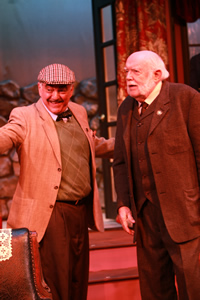 The show is performed in its original three act format with two intermissions. Given today’s fast paced get in-get out-go home mentality, the experience would be better served if Acts II and III were combined into one longer (but still manageable) act. The double break is a major distraction which only further dilutes the overall effectiveness of the show.
The show is performed in its original three act format with two intermissions. Given today’s fast paced get in-get out-go home mentality, the experience would be better served if Acts II and III were combined into one longer (but still manageable) act. The double break is a major distraction which only further dilutes the overall effectiveness of the show.
The living room set by designer Karen Ipock captures the time and place beautifully. She works wonders with the small space she is given; Ms. Kerns overcomes what could have become a theatrical traffic jam and works wonders fitting all ten players on the stage at one time. Unfortunately, the back wall, which is meant to conjure up an expansive view of the island and water below, is nothing more than a flat and lifeless scrim that takes the viewers out of the moment, nullifying any sense that you are actually on a deserted island.
If you are in the mood for a mild-mannered mystery with excellent performances, this production of And Then There Were None will be right up your alley. If, however, you are looking for an edge-of-your-seat nail biter, you would be better advised to book passage to another destination.
photos by Lindsay Schnebly
And Then There Were None
Actors Co-op at the David Schall Theatre in Hollywood
scheduled to end on November 18, 2012
for tickets, call (323) 462-8460 or visit http://www.ActorsCo-op.org
